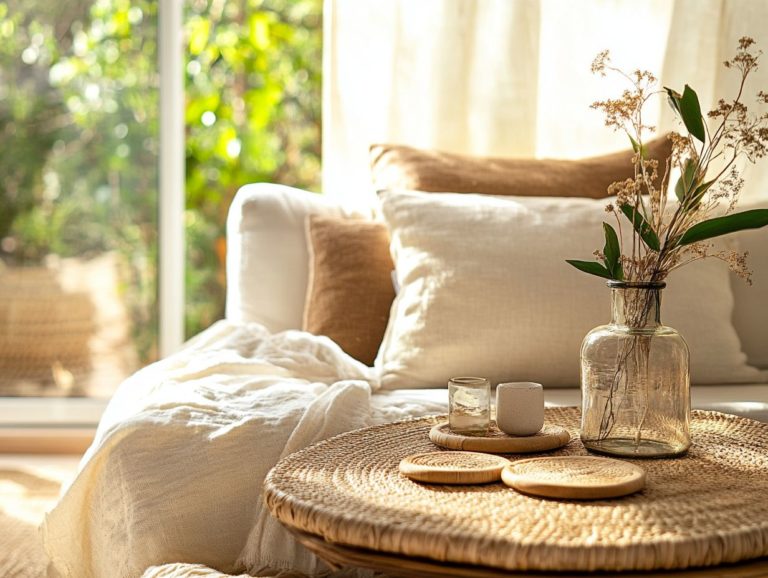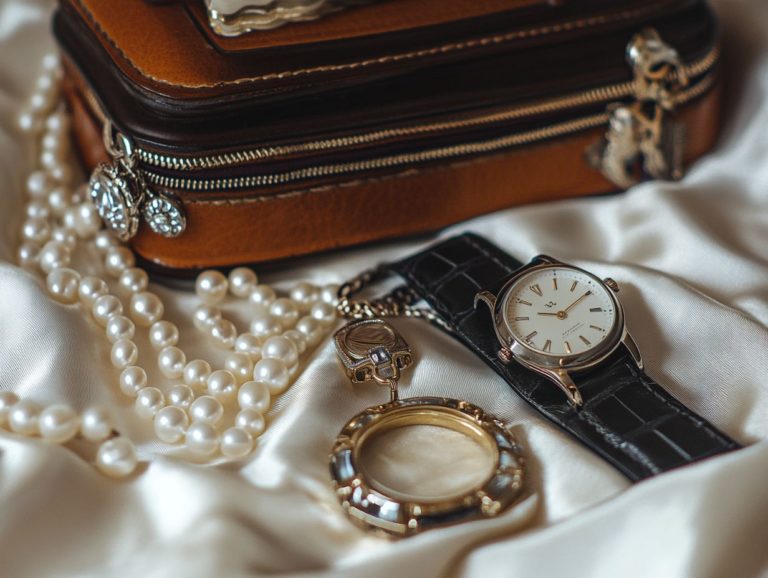How to Coordinate Home Accessories?
Coordinating home accessories is essential for crafting a cohesive and inviting atmosphere in your space. This guide will walk you through the fundamental elements of design, starting with selecting the perfect color scheme and identifying a complementary palette.
You ll discover how to mix patterns, textures, and scales to introduce visual interest and balance. We ll explore personal touches that reflect your unique style, along with practical tips for maintaining harmony across different rooms.
Jump in and create your dream home today!
Contents
- Key Takeaways:
- Understanding the Importance of Coordination
- Choosing a Color Scheme
- Mixing Patterns and Textures
- Playing with Scale and Proportion
- Incorporating Personal Style
- Tips for Coordinating Different Rooms
- Frequently Asked Questions
- How to Coordinate Home Accessories?
- 1. What is the first step in coordinating home accessories?
- 2. How do I decide which accessories to use?
- 3. Can I mix and match different styles of home accessories?
- 4. How many accessories should I have in a room?
- 5. Should I stick to one color for all my accessories?
- 6. How often should I change my home accessories?
Key Takeaways:

- Choose a color scheme for your home accessories by identifying a color palette and incorporating complementary colors.
- Mix patterns and textures to create visual interest, and play with scale and proportion to achieve balance and harmony in your home.
- Incorporate your personal style by adding unique touches, and follow tips to coordinate different rooms for a cohesive look throughout your home.
Understanding the Importance of Coordination
In the realm of home decor, grasping the significance of coordination is essential for crafting a warm and inviting atmosphere that truly reflects your personal style. For those looking to add character, learning how to style with vintage home accessories can enhance the visual charm of your living space while simplifying it by reducing visual tension, a common byproduct of over-decorating or excessive color and contrast.
Striking a harmonious balance between decorative accessories and empty spaces creates a tranquil sanctuary where your carefully chosen items blend effortlessly into a cohesive design. For tips on achieving this, check out how to curate a collection of home accessories.
Choosing a Color Scheme
Selecting a color scheme is a crucial step in home decor that can significantly shape the mood and atmosphere of your space. By opting for a limited palette, you simplify your environment while ensuring that your chosen hues harmonize beautifully.
Whether you lean towards soothing neutrals or bold accent colors that inject personality, the right colors can transform your home into a true reflection of your style.
Identifying a Color Palette
Identifying a color palette is essential for achieving a cohesive look throughout your home decor. This enables you to select accent pieces that beautifully complement your chosen hues. A well-defined palette simplifies decisions regarding furnishings, wall treatments, and decorative accessories, creating visual harmony that elevates your living space.
When selecting a color palette, consider the mood you want to evoke. Warmer tones like reds and oranges can energize a room, while cooler hues such as blues and greens foster a sense of tranquility. Start by choosing a dominant color, then explore two or three complementary shades to add depth. Incorporating accent colors through decor items like cushions, artwork, or vases will introduce visual interest without overwhelming your primary palette.
Don t forget to balance bold colors with neutrals to maintain a harmonious flow, making your space both inviting and visually appealing.
Incorporating Complementary Colors
Incorporating complementary colors into your home decor is a transformative way to create visual interest and contrast, significantly enhancing the overall aesthetic of your space. Thoughtfully placed decorative accessories in these complementary hues can elevate your design, manage visual tension, and ensure a balanced appearance.
By strategically pairing colors like blue with orange or yellow with purple, you can achieve a vibrant yet cohesive look. Consider using decorative items such as cushions, artwork, or curtains that showcase these striking color combinations to draw the eye and establish focal points within a room.
Understanding the principles of design, such as balance and harmony, will guide you in selecting pieces that not only complement each other but also unify the space. Additionally, knowing how to maintain home accessories can ensure that subtle accents in complementary shades enhance your existing decor, making your overall environment feel inviting and dynamic.
Mixing Patterns and Textures
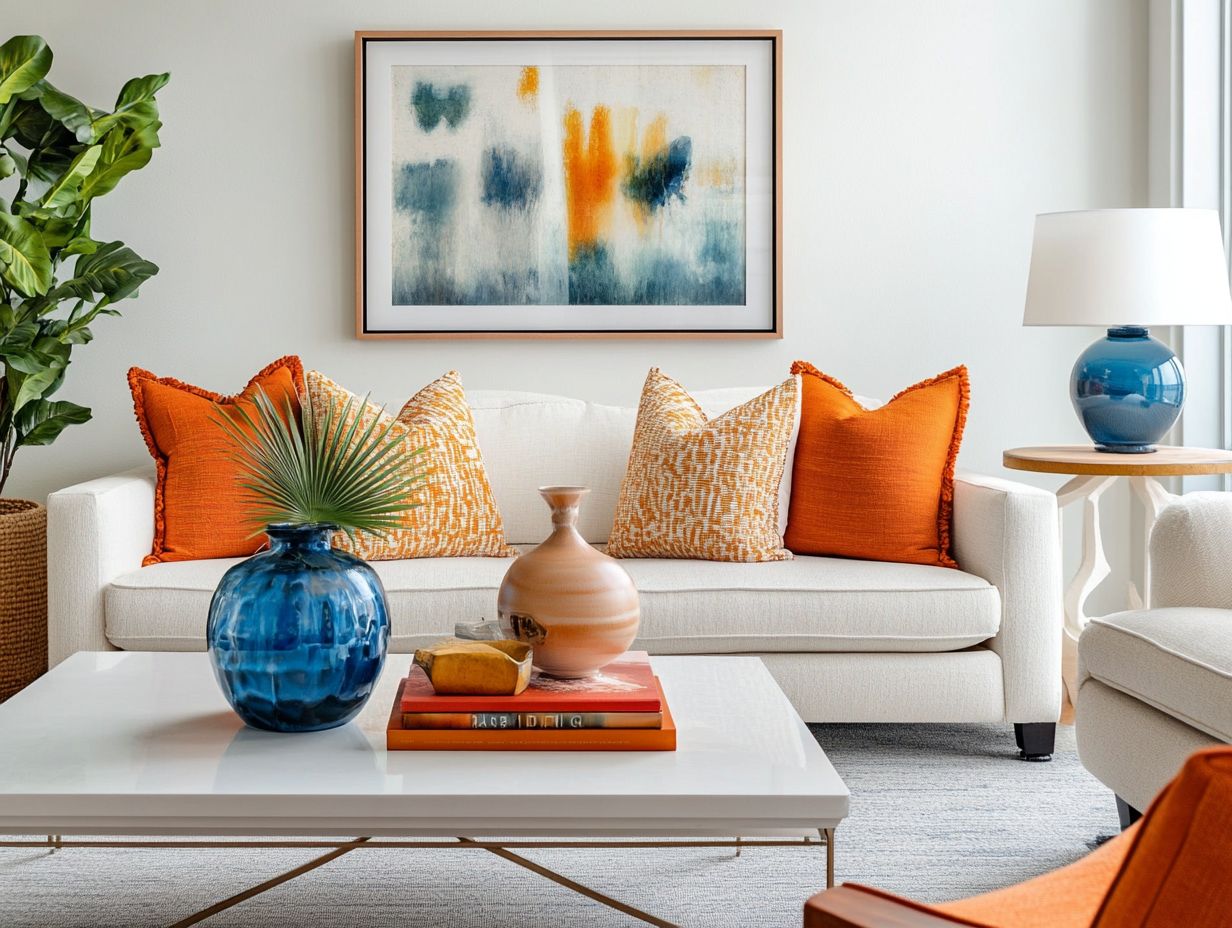
Mixing patterns and textures enhances the depth and visual intrigue of your home decor, turning an ordinary space into a vibrant, engaging environment.
By combining diverse textiles, colors, and patterns, you can create decorative vignettes (small arrangements) that reflect your unique style while ensuring a sense of unity throughout the space.
Creating Visual Interest
Creating visual interest in your home decor is essential for transforming your space into an inviting and dynamic oasis.
You can achieve this by layering accessories and incorporating various textures. Thoughtfully arranging decorative items and mixing different materials can elevate the overall aesthetic, just like understanding how to match accessories with furniture helps guide the eye throughout the room.
One effective approach is to position items of varying heights and shapes. For example, a tall vase next to smaller sculptures or candles adds depth and injects a refreshing rhythm into your decor.
Adding textiles like a cozy throw or a woven basket invites touch and interaction. Mixing metals, woods, and ceramics can further amplify the richness of your design.
The careful mix of these elements creates a cohesive and visually stimulating environment, turning every corner of your room into a feast for the eyes.
Playing with Scale and Proportion
Playing with scale and proportion is a key principle in home styling that can transform your perception of space and functionality.
By arranging furniture and decorative items of different sizes, you create a sense of balance and harmony, enhancing the visual appeal of your home d cor.
Creating Balance and Harmony
Creating balance and harmony in your home decor is essential for crafting a welcoming atmosphere.
Thoughtfully placing functional items alongside decorative accessories can enhance your space. For tips on creating a cohesive look, check out this guide on how to use accessories for a themed decor, cultivating a visually appealing environment that reflects your unique style while avoiding clutter.
Consider the scale and proportion of your pieces; oversized furniture pairs well with larger accessories, and smaller decor items can serve as accents.
Incorporating a variety of textures and colors differentiates areas and introduces depth to your design, making your space feel lively and welcoming.
Choosing multi-functional furniture, like ottomans or storage benches, maximizes your space and enhances the overall aesthetic. Your careful selection and arrangement of these elements will create a sanctuary that feels beautifully organized.
Incorporating Personal Style
Incorporating your personal style into home decor is essential for creating a space that feels distinctly yours and aligns with your lifestyle.
By choosing unique touches and accent pieces that embody your individuality, you infuse character into your living environment while ensuring harmonious design.
Adding Unique Touches
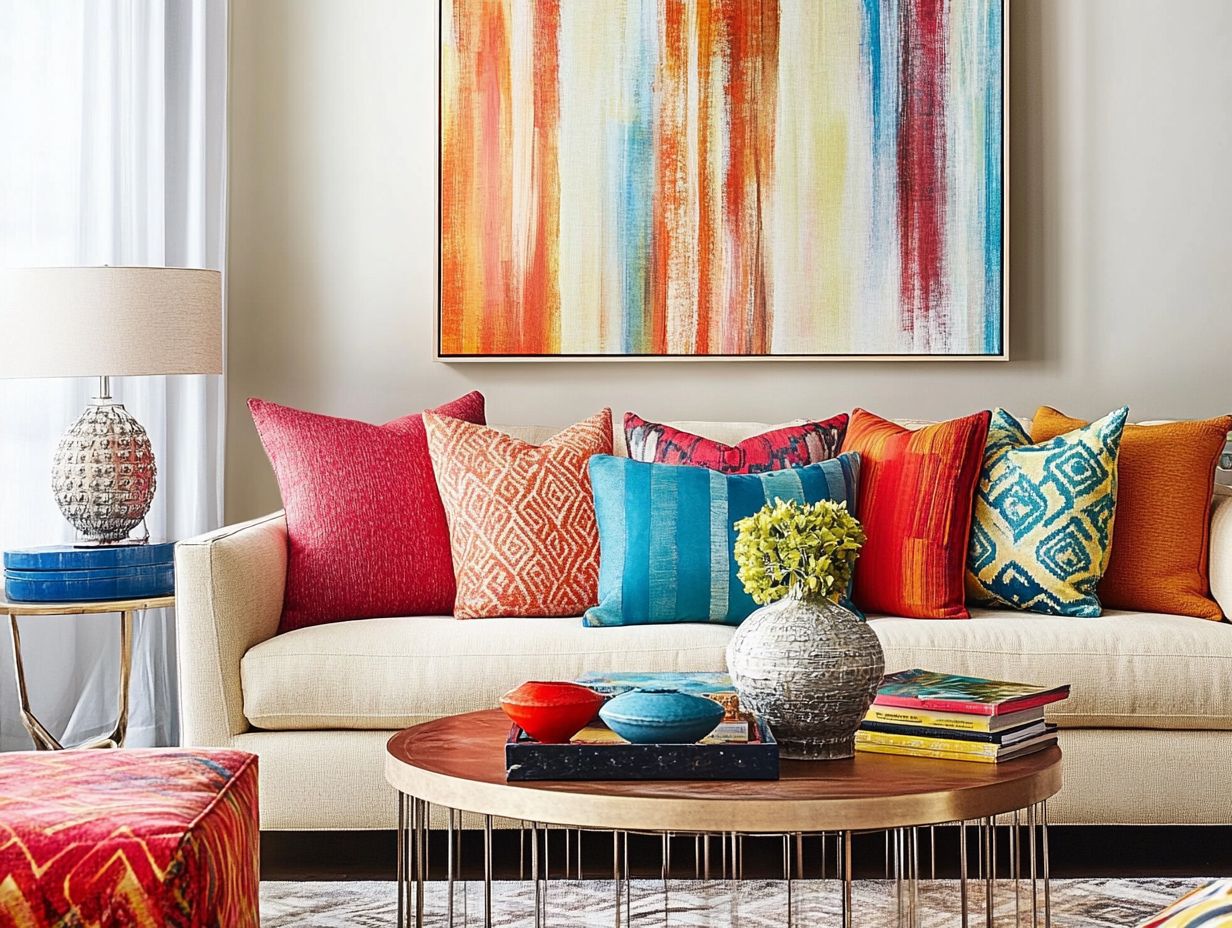
Adding unique touches to your home decor is a great way to personalize your space.
Whether you select accent colors or distinctive decorative accessories, these elements can create an inviting atmosphere that reflects your taste.
Incorporating pops of color like vibrant throw pillows or striking artwork elevates the overall aesthetic and breathes life into any room.
Accent colors connect individual elements, creating a unified look that feels intentional.
Decorative accessories, such as handmade vases or charming trinkets from your travels, serve functional purposes and tell a story, inviting guests to engage in conversation.
By thoughtfully blending these elements, you achieve a balance that merges personal sentiment with visual appeal, transforming an ordinary space into a warm, welcoming retreat.
Don’t wait to transform your space!
Tips for Coordinating Different Rooms
Coordinating the various rooms in your home is essential for crafting a cohesive look that transitions smoothly from one space to another, and learning how to refresh your home with accessories can enhance this process.
Implementing a consistent color scheme and considering your furniture arrangement can establish a unified aesthetic that elevates your home s overall decor.
Creating a Cohesive Look Throughout the Home
Start with a well-defined design plan. Highlight your chosen color palette and thematic elements.
Select accent pieces and decorative items that align with your overall vision. For more tips on creating a cohesive look, check out this guide on how to personalize your home accessories. Each room should contribute to a unified aesthetic.
This approach enhances visual harmony and creates a sense of comfort and flow as you transition from one space to another.
Integrate complementary textures, patterns, and materials that reflect your chosen hues, whether you prefer a soothing soft gray or a vibrant teal.
Incorporating versatile furniture can seamlessly unify diverse areas within your home. Thoughtful layering of decor such as art, textiles, and lighting reinforces this cohesive ambiance, making your home feel stylish and inviting.
Frequently Asked Questions
How to Coordinate Home Accessories?
Ready to transform your home? Coordinating accessories can be an exciting adventure! If you’re looking for inspiration, check out this guide on how to style your home with accessories. Here are some frequently asked questions to guide you:
1. What is the first step in coordinating home accessories?
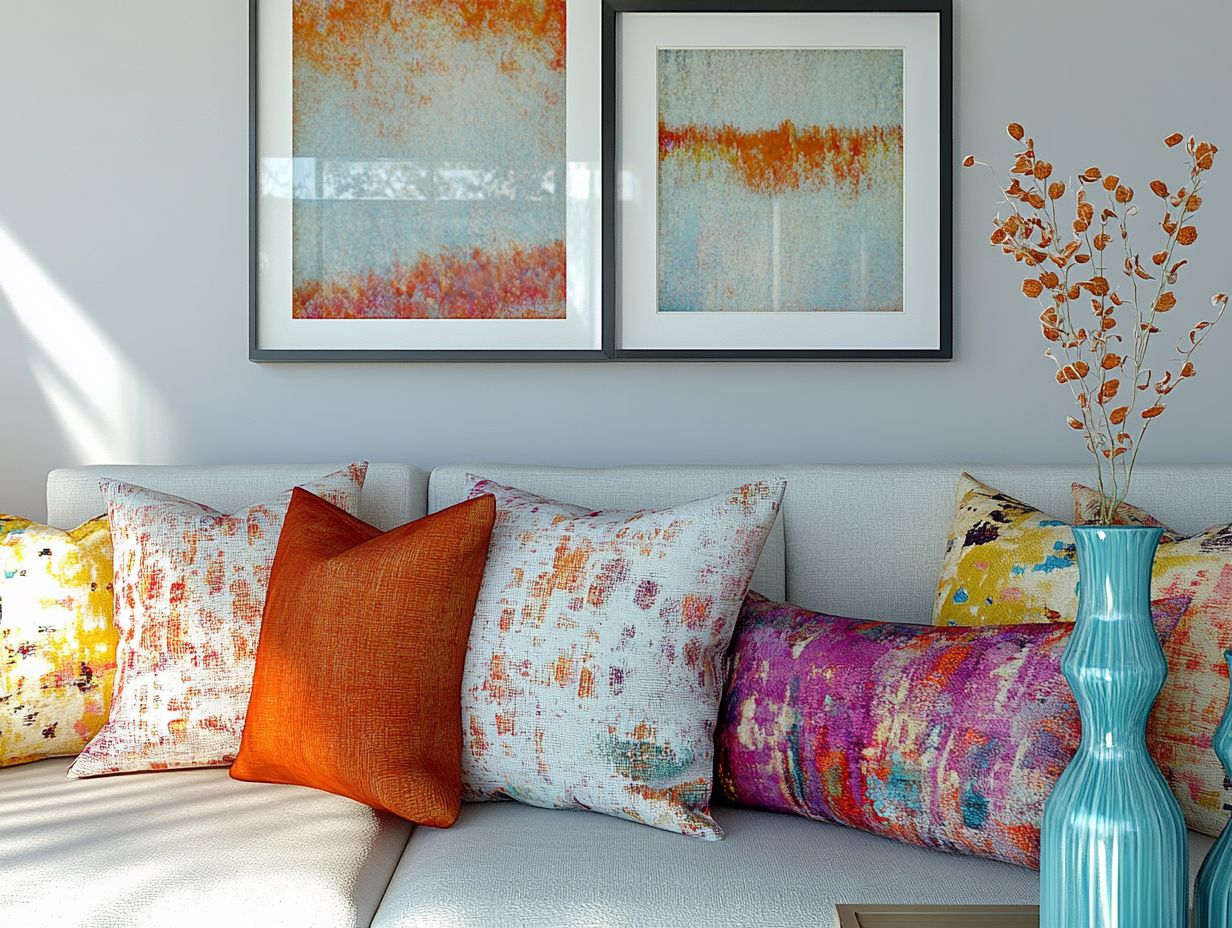
The first step is to choose a color scheme or theme for your home. This will help determine how to use color in home accessories that will work best together.
2. How do I decide which accessories to use?
Think about the purpose of each room and the mood you want to create. For example, a living room may need functional and decorative items, while a bedroom may only need decorative items.
3. Can I mix and match different styles of home accessories?
Yes! You can mix and match different styles as long as they complement each other. Use a mix of textures and patterns to add interest to the room.
4. How many accessories should I have in a room?
It’s important to strike a balance and not overcrowd a room with too many accessories. A general rule is to have a maximum of three to five accessories per surface, such as a coffee table or bookshelf.
5. Should I stick to one color for all my accessories?
No! It’s not necessary to use only one color for all your accessories. However, having a color scheme or theme helps tie everything together. You can add pops of color with smaller accessories or use various colors within the same color family.
6. How often should I change my home accessories?
There’s no set rule for how often to change your home accessories. It’s a good idea to update them every few years or whenever you feel like refreshing the look of your home. Switching out accessories seasonally can also give your home a new look.
Explore more articles or start your home makeover today!

